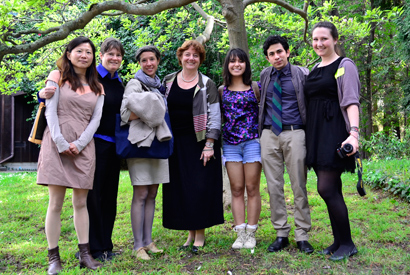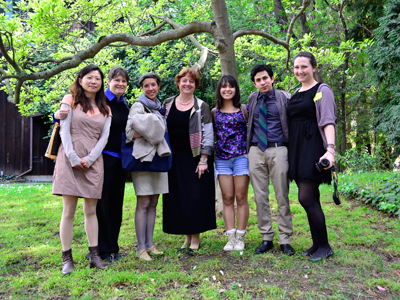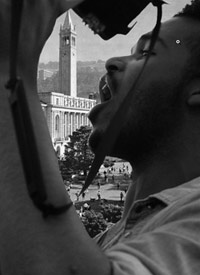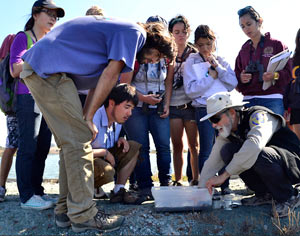Contest winners shine new light on Fiat Lux
The Fiat Lux Remix contest invited students, faculty and staff members to revisit images of UC campuses commissioned in the mid-1960s by then-President Clark Kerr and taken by legendary photographer Ansel Adams – and published in the book Fiat Lux – and give them their own spin.

April 9, 2013
Seven UC Berkeley students have been named winners of a contest designed to bring a 21st-century perspective to a nearly 50-year-old vision of the future of the University of California. Two students, Luis Flores and Elena Kempf, were selected as grand-prize winners.

From left, Yuan Chen, program director Alix Schwartz, instructor Amanda Eicher, lead faculty member Catherine Cole, Sheila Wagner and grand-prize winners Luis Flores and Elena Kempf. Not pictured: Pauline Autet, Joseph Mann and Everto Gutierrez. (Everto Gutierrez photo)
The Fiat Lux Remix contest invited students, faculty and staff members to revisit images of UC campuses commissioned in the mid-1960s by then-President Clark Kerr and taken by legendary photographer Ansel Adams – and published in the book Fiat Lux – and give them their own spin. The seven winners had their creations displayed (along with other student works responding to Adams’ images) at the Worth Ryder Art Gallery in February. Later they met with the UC regents, including some lively debate with board member Gov. Jerry Brown.
“We had quite a voluble and wide-ranging discussion about higher education,” says Catherine Cole, a professor in the Department of Theater, Dance and Performance Studies, who oversaw the contest. “Governor Brown is an animated and even combative conversationalist. I was really thrilled that [the contest winners] had that opportunity.”
Named for UC’s motto– which translates as “Let there be light”– Fiat Lux, published in 1967, was meant to imagine the ways higher education in the state might change in the century to come. In 2012, it became the focus of On the Same Page,a campus program that gives incoming students a theme to explore together. More than 7,500 new UC Berkeley students received a reprint of the book, and seminars, exhibits and other projects viewed the images from a variety of academic perspectives.
The contest– which invited entrants to “remix” or repurpose Adams’ pictures, which were made available online– was inspired in part by the photographer’s forward-thinking ideas about the potential for endless new interpretations of existing art.
“Adams was an accomplished pianist, and he saw the photographic negative as being akin to a composer writing down a score,” explains Cole, who served as On the Same Page’s lead faculty member last year. “The only way musicians have historically gotten access to compositions of the past is when the music was written down– and then people in the future could play and reinterpret the score.
“So Adams, in his autobiography, expressed a remarkably generous sentiment,” Cole says. “He wished for his own negatives to be made available in a university setting to advanced students and artists for them to ‘play’ and perform the score. He wished that if could return to the world 20 years after his death, he might find astonishing reinterpretations of his most iconic images.”
It looks like Adams got his wish.
The winners are:
Grand prize– Luis Flores
Contest entry: “The American University and the Establishment of Neoliberal Hegemony,” an essay.
Flores (like co-grand prize winner Elena Kempf) received a $500 American Express gift card for his contest entry, which explores how the university responds (or sometimes doesn’t) in times of crisis.
“My question was one similar to that explored in Fiat Lux,” says Flores, who graduated in December with a degree in political economy and history. ” ‘How did we get here, and how can we use a historical understanding to reimagine the future of the university?'”
Despite the hard work that went into his research-packed paper, Flores didn’t expect an essay to win a contest devoted to reinterpreting old photographs. But he says he’s pleased that his paper gave him the opportunity to take part in the discussions sparked by On the Same Page’s Fiat Lux focus.
“I presume that Fiat Lux was, after all, about getting people together to have these in-person discussions about the university,” he says. “It’s clear that the process of reimagining must also be collective.”
Grand prize– Elena Kempf
Contest entry: “Fight for Public Education,” a photograph.
A second-year student majoring in history, Kempf decided to focus her contest entries on an important part of UC Berkeley history that wasn’t on view in Adams’ photos: dissent.

Elena Kempf’s prize-winning photo remix, “Fight for Public Education”
“I had taken a great many photos at the 2012 protests against tuition hikes and had been thinking about how to play with them in a creative way for quite a while,” she says. “I found Ansel Adams’ photos inspiring, so I set my photos and his into conversation.”
Kempf ended up submitting three pictures. One, “Generations,” was picked as a semi-finalist in September. The other, “Fight for Public Education,” made her a grand-prize winner. It shows a protestor with a megaphone superimposed over one of Adams’ shots of the Campanile.
“While Adams’ photos are stunning, it is clear that his vision of the future of UC was inspired by a time when the Golden State and its public universities didn’t face fiscal struggles of the kind they’re experiencing now,” Kempf says. “His outlook was truly golden. Going forward, the voice of dissent [and] those at the margins will have to be part of the conversation. However, dissent needs to be focused around the ideals of the University of California, as the framing of the protester around the Campanile demonstrates. In the center stands what makes Berkeley such a wonderful place: tradition, excellence, compassion and so much more.”
Honorable Mention– Pauline Autet
Contest entry: “A Call to Care,” a booklet that looks at UC’s future from a student perspective.
French by birth but now living in New Zealand, Autet came to Berkeley for a one-semester exchange last fall. What she found impressed her.
“I was inspired by the drive and passion that I felt throughout the campus community,” she says. “Students really care about the future and are willing to give their time and effort to advocate for that. I wanted to present a research booklet which would be…a representation of what goes on in students’ heads.”
A photographer herself, Autet created her booklet using her own pictures as well as research she did as part of the On the Same Page class “Fiat Lunch: Curatorial and Social Practices and the UC Ansel Adams Archive.”
“Mostly my message is a call to honest and committed service and collaboration between student bodies and institutional leaders,” she says, “as well as a rejection of greed, business-oriented education and exclusion of student voices in running the system.”
Honorable Mention– Yuan Chen
Contest entry: “The Lettuce Picker,” an acrylic painting.
Assigned in a painting class to reimagine a photograph from Fiat Lux, Chen picked one that was far from the stereotypical image of UC. Called “Lettuce Picking Machine, Salinas Valley, 1966,” it depicts a group of farmers inspecting the machine, which had been invented by the agricultural- engineering department at UC Davis.
“I love the shape of the machine,” says Chen, a junior who transferred to Berkeley after a year at the College of Marin. “For me, the roundness of it and the cylindrical nature of its operation represent fulfillment. Additionally, the machinery symbolized the discipline which I set as my goal for my time at UC Berkeley.”
Though she’s currently undeclared, Chen says she plans to major in art practice. She already has an artistic disposition: She admits that, for her, the meeting with the regents was interesting but intimidating. (“Like many artists, I am most comfortable when engaged in my work,” she says.) Yet she had no such mixed feelings about having her work on display with the other winning entries.
“I was so honored to be chosen for this,” she says. “As an artist, it is always encouraging when your work can be appreciated and enjoyed by others.”
Honorable Mention– Everto Gutierrez
Contest entry: “Field Day,” a photograph.
Gutierrez snapped his winning picture while on a three-day field trip for an environmental problem-solving course he was taking. The photo echoes an Adams image of a professor talking to his students about genetics while in the field.

Detail of Everto Gutierrez’s “Field Day”
“In his picture, you see a very diverse group of individuals in terms of race and gender, something not common in higher education,” says Gutierrez. “I show the same type of group and, like Adams, I don’t give an answer, I ask questions. Who are these individuals? Where do they come from? What is their background?”
One question Gutierrez will answer emphatically is “What did you think of meeting the regents?”
“The regents meeting was awesome,” says the fourth-year student, who’s majoring in conservation and resource studies with a focus on environmental media and human perception). Gutierrez particularly enjoyed the opportunity to share ideas with the governor and UC President Mark Yudof. While “there were very serious talks about the faculty-student relationship,” Gutierrez says the regents and contest winners also found themselves discussing the big news of the day.
“The new pope was a hot subject,” he says.
Honorable mention– Joseph Mann
Contest entry: “Rephotography at the Big C,” a Photoshopped image.
A third-year Asian studies major, Mann was inspired to enter the contest after he noticed that a Fiat Lux shot he’d seen on display was strikingly similar to one he’d taken himself just weeks before. Both photos look out over the campus, the surrounding city and the bay from “the Big C,” the famous concrete “C” in the Berkeley hills. Using techniques he’d learned in a Fiat Lux workshop, Mann combined the images.
“My goal had been to show the changes that UC Berkeley had undergone since the original photograph,” he says. “Unfortunately– or perhaps fortunately– the differences were in some ways so subtle that the finished product came to represent something entirely different than I had originally expected.”
While Mann was fascinated by the blending of color and black-and-white, some saw in the combined images a reflection of Berkeley’s changing demographic makeup.
“Seeing my photo on exhibit was really cool,” Mann says. “It’s definitely something I was pretty proud of.”
Honorable mention– Sheila Wagner
Contest entry: “Fiat Lux,” a Photoshopped image.
When Wagner first read about the contest, she immediately knew what “remix” meant to her: collage. Wagner was already fascinated with the technique, using images culled from magazines to create new works of art. In the past she’d created her pieces through old-fashioned cutting and pasting, but having so many Fiat Lux photos available digitally convinced her to give Photoshop a try.
“I looked through every Adams photograph and sought out images that I thought represented what the university means to me,” says Wagner, a second-year film studies major. “A place of ethnic and cultural diversity. A place where the arts and the sciences can thrive and flourish. A guiding light for the young and old. The contest really allowed me to reflect on and consider the value of my school, UC Berkeley, as well as the entire educational system.”
Wagner says it was “beyond awesome” to see her piece on display. She also appreciated the opportunity to share thoughts about UC’s future with. Brown. That meeting of the minds at the regents’ meeting had an unexpected downside, however.
“My conversation with Governor Brown was so long I ended up missing a French test,” Wagner says. “Imagine my French teacher’s surprise when she received an email from the governor of California excusing my absence.”